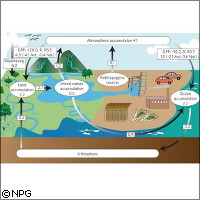Scientists say geoengineering key for fight against global warming
A new international report calls on governments and researchers to turn their attention to geoengineering to counteract the effects of global warming from greenhouse gas emissions, but not to overlook conventional climate mitigation strategies. In their commentary 'The Boundless Carbon Cycle', published in the journal Nature Geoscience, scientists from Austria, Belgium, Sweden and the US say the existing global strategies to mitigate man-made carbon emissions and address climate change have overlooked inland waters - a major component of the global carbon cycle. The scientists say conventional carbon-cycling models fail to explain the significant roles rivers, lakes, streams, reservoirs and wetlands play in the carbon cycle. The commentary was released in advance of COP15, the UN Climate Change Conference that will be held in Copenhagen, Denmark in December of this year. Representatives from 192 countries will meet to reach a decision on a 2012 climate agreement that will succeed the Kyoto Protocol, a protocol to the UN Framework Convention on Climate Change (UNFCCC), and a global environmental treaty targeting the 'stabilisation of greenhouse gas concentrations in the atmosphere at a level that would prevent dangerous anthropogenic interference with the climate system'. 'While inland waters represent only 1% of the Earth's surface, their contribution to the carbon cycle is disproportionately large, underestimated, and not recognised within the models on which the Kyoto Protocol was based,' explains Dr Tom J. Battin of the Department of Freshwater Ecology at the University of Vienna, and lead author of the paper. The existing carbon models take into inland waters static conduits that transfer carbon from the continents to the oceans, according to the scientists. It is possible that inland waters can change the 'fates of terrestrial carbon delivered' to the oceans. For example, carbon can be buried in sediments which could result in long-term storage or sequestration. 'Twenty percent of the continental carbon sequestration actually occurs as burial in inland water sediments,' says Professor Lars Tranvik of Uppsala University in Sweden. For his part, Dr Anthony K. Aufdenkampe of the Stroud Water Research Center in the US, says: 'River outgassing of respired carbon contributes carbon to the atmosphere in an amount equivalent to 13% of annual fossil fuel burning.' According to the team, this source of carbon to the atmosphere suggests that more continental carbon sinks exist including higher rates of biomass accrual in forests. 'A larger accumulation of carbon in forest ecosystems that could offset the outgassing from rivers would be more consistent with current independently derived estimates of carbon sequestration on the continents,' Dr Sebastian Luyssaert of the University of Antwerp in Belgium is quoted as saying. A boundless carbon cycle accounts for carbon transfers between the freshwater-land boundary, the freshwater-atmosphere boundary, and regional boundaries within continents, according to the scientists, who also state that extensive research could fuel understanding and give new insights into carbon cycles across terrestrial and aquatic ecosystems.
Countries
Austria, Belgium, Sweden, United States



